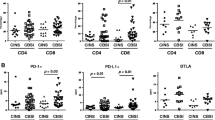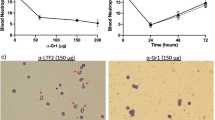Abstract
The aim of the present study was to investigate the contribution of granulocytes and monocytes to resistance against an acute systemic candidal infection in mice. To this end granulocytopenia and monocytopenia were induced by irradiation or treatment with cyclophosphamide, and monocytopenia was obtained by treatment with VP-16. After intravenous injection of 1×104 Candida albicans into mice irradiated with 8 GY, the number ofCandida albicans cultured from the kidneys, expressed as the geometric mean of the number of CFU/g tissue, was 5.4×104, 7.1×106 and 5.8×107 on days 1, 3 and 5 of infection respectively (p<0.001 compared to normal mice). The number ofCandida albicans cultured from the liver and spleen was also significantly higher for irradiated animals than for normal mice (p<0.001). For cyclophosphamide-treated mice the number of organisms in the kidney (1.7×104 CFU/g on day 1, 1.9×106 on day 3 and 3.8×106 on day 5 of infection) and spleen was significantly higher (p at least <0.02) than for nomal mice after injection of 1×103 Candida albicans. Monocytopenia induced by VP-16 did not result in an increase in the number ofCandida albicans cultured from the kidney or spleen after infection. From these studies it is concluded that granulocytes and not monocytes or exudate macrophages play an important role in resistance againstCandida albicans during the first five days of a systemic infection.
Similar content being viewed by others
References
Cutler, J. E. Acute systemic candidiasis in normal and congenitally thymic-deficient (nude) mice. Journal of the Reticuloendothelial Society 1976, 19: 121–124.
Giger, D. K., Domer, J. E., McQuitty, J. T.: Experimental murine candidiasis: pathological and immune responses to cutaneous inoculation withCandida albicans Infection and Immunity 1978, 19: 499–509.
Giger, D. K., Domer, J. E., Moser, S. A., McQuitty, J. T. Experimental murine candidiasis: pathological and immune responses in T-lymphocyte-depleted mice. Infection and Immunity 1978, 21: 729–737.
Kagaya, K., Shinoda, T., Fukazawa, Y. Murine defense mechanisms againstCandida albicans infection. Microbiology and Immunology 1981, 25: 647–654.
Kirkpatrick, C. H. Host factors in defense against fungal infections. American Journal of Medicine 1984, 77: 1–12.
Pearsall, N. N., Lagunoff, D. Immunological responses toCandida albicans. I: Mouse-thigh lesion as a model for experimental candidiasis. Infection and Immunity 1974, 9: 999–1002.
Pearsall, N. N., Adams, B. L., Bunni, R. Immunological responses toCandida albicans. III: Effects of passive transfer of lymphoid cells or serum on murine candidiasis. Journal of Immunology 1978, 120: 1176–1180.
Rogers, T. J., Balish, E., Manning, D. D. The role of thymus-dependent cell-mediated immunity in resistance to experimental disseminated candidiasis. Journal of the Reticuloendothelial Society 1976, 20: 291–298.
Hurtrel, B., Lagrange, P. H., Michel, J.-C. Absence of correlation between delayed type hypersensitivity and protection in experimental systemic candidiasis in immunized mice. Infection and Immunity 1981, 31: 95–101.
Louria, D. B. Candida infections in experimental animals. In: Bodey, G. P., Fainstein, V. (ed.): Candidiasis. Raven Press, New York, 1986, p. 29–51.
Lehrer, R. I. The fungicidal mechanisms of human monocytes. I: Evidence for myeloperoxidase-independent candidicidal mechanisms. Journal of Clinical Investigation 1975, 55: 338–346.
Lehrer, R. I., Ladra, K. M., Hake, R. B. Nonoxidative fungicidal mechanisms of mammlian granulocytes: demonstration of components with candidacidal activity in human, rabbit, and guinea pig leukocytes. Infection and Immunity 1975, 11: 1226–1234.
Lehrer, R. I., Ferrari, L. G., Paterson-Delafield, J., Sorrel, T. Fungicidal activity of rabbit alveolar and peritoneal macrophages againstCandida albicans. Infection and Immunity 1980, 28: 1001–1008.
Leijh, P. C. J., van den Barselaar, M. T., van Furth, R. Kinetics of phagocytosis and intracellular killing ofCandida albicans by human granulocytes and monocytes. Infection and Immunity 1977, 17: 313–318.
Morrison, R. P., Cutler, J. E. In vitro studies of the interaction of murine phagocytic cells withCandida albicans. Journal of the Reticuloendothelial Society 1981, 29: 23–34.
Ehrensaft, D. V., Epstein, R. B., Sarpel, S., Andersen, B. R. Disseminated candidiasis in leucopenic dogs. Proceedings of the Society for Experimental Biology and Medicine 1979, 160: 6–10.
Hurtrel, B., Lagrange, P. H., Michel, J.-C. Systemic candidiasis in mice. II: Main role of polymorphonuclear leukocytes in resistance to infection. Annales d'Immunologie 1980, 131 C: 105–108.
Nugent, K. M., Onofrio, J. M. Pulmonary clearance ofCandida albicans in neutropenic mice. Journal of Infectious Diseases 1984, 149: 1020.
Joyce, R. A., Chervenick, P. A. Corticosteroid effect on granulopoiesis in mice after cyclophosphamide. Journal of Clinical Investigation 1977, 60: 277–283.
Bodey, G. P. Candidiasis in cancer patients. American Journal of Medicine. 1984, 77: 13–19.
Horn, R., Wong, B., Kiehn, T. E., Armstrong, D. Fungemia in a cancer hospital: changing frequency, earlier onset, and results of therapy. Reviews of Infectious Diseases 1985, 7: 646–655.
Bistoni, F., Vecchiarelli, A., Mazzolla, R., Puccetti, P., Marconi, P., Garaci, E. Immunoadjuvant activity of amphotericin B as displayed in mice infected withCandida albicans. Antimicrobial Agents and Chemotherapy 1985, 27: 625–631.
De Brabander, M., Aerts, F., van Cutsem, J., van den Bossche, H., Borgers, M. The activity of ketoconazole in mixed cultures of leukocytes andCandida albicans. Sabouraudia 1980, 18: 197–210.
van Furth, R. Phagocytic cells: development and distribution of mononuclear phagocytes in normal steady state and inflammation. In: Gallin, J. I., Goldstein, I. M., Snyderman, R. (ed.): Inflammation: basic principles and clinical correlates. Raven Press, New York 1988, p. 281–296.
Sohnle, P. G., Frank, M. M., Kirkpatrick, C. H. Mechanisms involved in elimination of organisms from experimental cutaneousCandida albicans infections in guinea pigs. Journal of Immunology 1976, 117: 523–530.
Bistoni, F., Vecchiarelli, A., Cenci, E., Puccetti, P., Marconi, P., Cassone, A. Evidence for macrophage-mediated protection against lethalCandida albicans infection. Infection and Immunity 1986, 51: 668–674.
Author information
Authors and Affiliations
Rights and permissions
About this article
Cite this article
van 't Wout, J.W., Linde, I., Leijh, P.C.J. et al. Contribution of granulocytes and monocytes to resistance against experimental disseminatedCandida albicans infection. Eur. J. Clin. Microbiol. Infect. Dis. 7, 736–741 (1988). https://doi.org/10.1007/BF01975039
Issue Date:
DOI: https://doi.org/10.1007/BF01975039




